If you’re searching for the best plant-growing science kits to spark your child’s interest, I recommend exploring options like kits with transparent root viewers, indoor grow lights, and eco-friendly maze or puzzle activities. These engage kids with hands-on experiments, promote learning about plant biology, and make gardening fun. By choosing age-appropriate and safe kits with clear instructions, you’ll help nurture their curiosity and responsibility. Keep exploring to discover more about these exciting options.
Key Takeaways
- Highlight kits designed for different age groups, ensuring age-appropriate complexity and safety.
- Emphasize educational features like plant biology, root observation, and sustainability to inspire young botanists.
- Include a variety of growing methods, such as indoor grow lights, transparent viewers, and eco-friendly maze activities.
- Prioritize kits made from durable, non-toxic materials with clear instructions to promote engagement and long-term learning.
- Showcase options with interactive elements like journals, stickers, and real plant growth monitoring to boost curiosity and responsibility.
Kids Plant Growing Kit with Irrigation & Grow Light
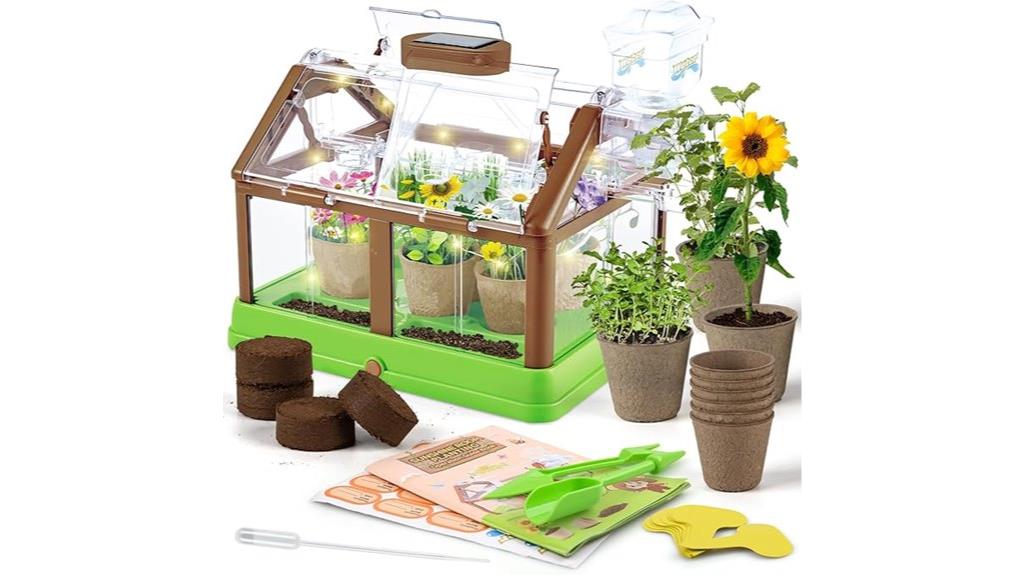
If you’re looking for an engaging and educational plant-growing kit for kids aged 3 to 15, the Kids Plant Growing Kit with Irrigation & Grow Light is an excellent choice. I love how it includes everything needed—mini greenhouse, seeds, soil, irrigation system, solar grow light, and fun accessories like stickers and fairy lights. The greenhouse creates a perfect environment for seedlings, while the solar-powered light activates at night, making the process effortless. Kids learn about plant life cycles, responsibility, and science through hands-on activities, making this kit ideal for family projects or classroom use. It’s simple to assemble and offers a rewarding gardening experience.
Best For: parents, teachers, and children aged 3 to 15 seeking an educational, engaging, and easy-to-use gardening activity that promotes responsibility, science learning, and outdoor play.
Pros:
- Comprehensive kit with all necessary components for a complete gardening experience.
- Educational benefits include teaching about plant life cycles, greenhouse functions, and responsibility.
- Supports emotional well-being by providing a calming, screen-free activity that fosters patience and creativity.
Cons:
- May require adult supervision for younger children during assembly and watering.
- Limited plant variety included, which might reduce long-term interest for some kids.
- The greenhouse size and components might be less suitable for very small children to handle independently.
STEM Plant Growing Kit for Kids (Ages 8–12)
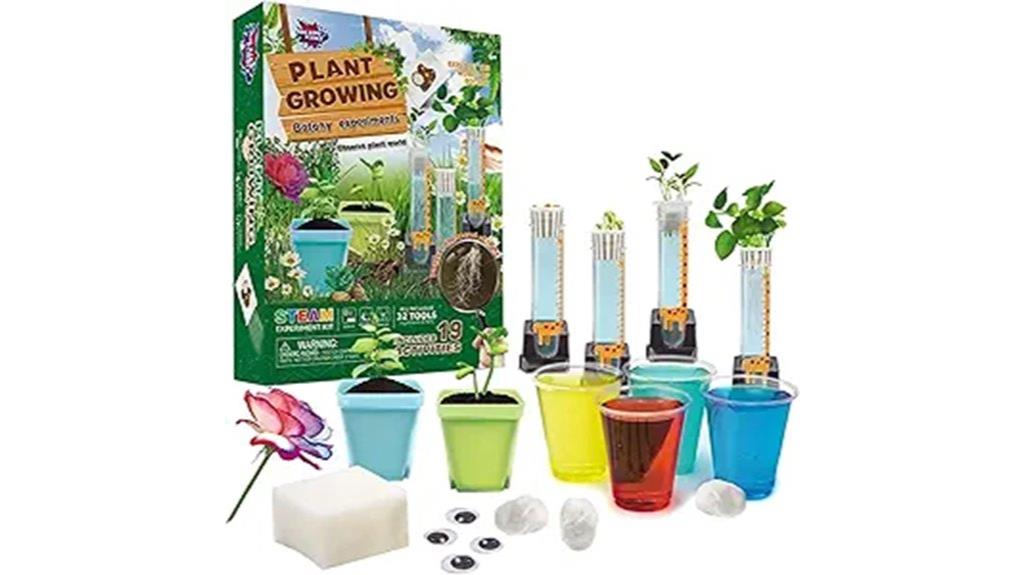
The STEM Plant Growing Kit for Kids (Ages 8–12) is an excellent choice for young science enthusiasts enthusiastic to explore plant biology through hands-on experiments. It includes 19 experiments that cover germination, root development, water transport, transpiration, and hydroponics, using tools like test tubes, magnifiers, and stickers. Designed without batteries or seeds, it encourages active learning and observation. Kids can sprout pantry seeds, watch root systems in test tubes, and experiment with water uptake. Made from non-toxic materials, it’s perfect for school, home, or as a gift. This kit sparks curiosity, enhances scientific thinking, and promotes patience, making plant science engaging and educational.
Best For: parents, teachers, or gift-givers seeking an engaging, educational plant science kit for children aged 8–12 to foster curiosity and hands-on learning.
Pros:
- Includes 19 interactive botanical experiments that teach germination, root growth, and water transport
- Made from non-toxic, lab-tested materials ensuring safety for kids
- Encourages scientific thinking, observation skills, patience, and responsibility
Cons:
- Missing or limited test tubes, stands, and a smaller magnifier may reduce usability
- Seeds are not included, requiring additional planning and purchase prior to experiments
- Some basic experiments might be less challenging for older children or those with prior science experience
Kids Plant Growing Kit with Hydroponic System and Tools
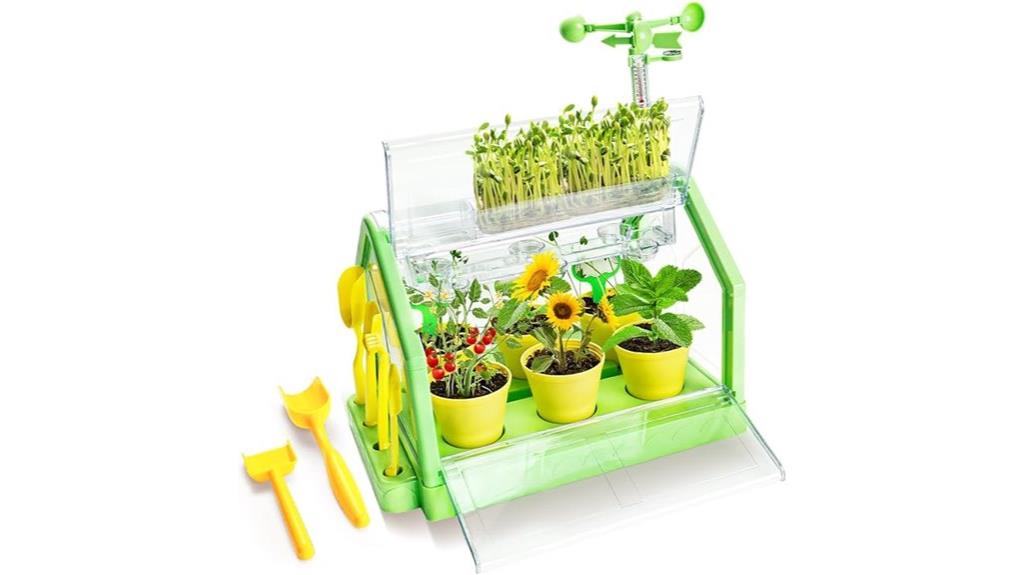
Kids Plant Growing Kit with Hydroponic System and Tools stands out as an excellent choice for children interested in hands-on science and gardening. It includes a complete indoor greenhouse setup, with a hydroponic system, gardening tools, wind vane, thermometer, and educational materials. Kids can build mini gardens, plant seeds, and watch the entire growth cycle, from germination to flowering and fruiting. This kit promotes experiential learning by integrating botany, meteorology, and environmental science. Plus, gardening helps reduce stress and improve mood, making it a fun, practical, and therapeutic activity that fosters responsibility and curiosity in young learners.
Best For: children interested in hands-on science, gardening, and experiential learning who want to explore plant growth indoors while developing responsibility and curiosity.
Pros:
- Encourages STEM education through practical plant cultivation and environmental observation
- Supports emotional well-being by reducing stress and boosting mood through gardening activities
- Includes a comprehensive set of tools and educational materials for an engaging, full plant growth experience
Cons:
- May require adult supervision for safe handling of tools and plant care
- Limited space may restrict larger garden projects or multiple plant types
- Some children might find hydroponic systems complex without proper guidance
Klever Kits 2-in-1 Root Viewer & Planting Science Kit for Kids
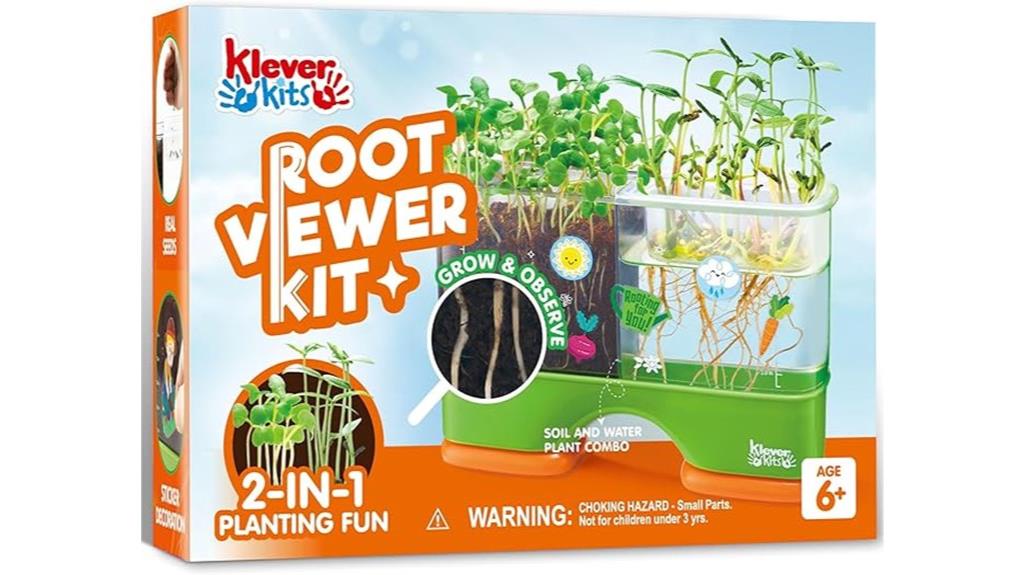
Designed for young learners enthusiastic to explore plant growth firsthand, the Klever Kits 2-in-1 Root Viewer & Planting Science Kit stands out as an engaging educational tool. It offers both hydroponic and soil growing experiences, allowing kids to compare how plants develop in different environments. The transparent root viewer makes it easy to observe root growth from sprouting to expansion, sparking curiosity. With colorful stickers for personalization and quick, mess-free setup using Minute Soil, it’s perfect for children aged 6 and up. This kit not only teaches scientific observation and patience but also makes gardening fun and accessible for budding botanists.
Best For: young children aged 6 and above who are interested in hands-on gardening, plant science, and STEM learning activities.
Pros:
- Offers dual hydroponic and soil growing experiences for comprehensive learning.
- Transparent root viewer allows kids to observe root development directly, enhancing curiosity and understanding.
- Includes fun personalization options with colorful stickers and simple setup with Minute Soil for mess-free use.
Cons:
- May require adult supervision for younger children during setup and observation.
- Limited to growing mung beans and radishes, which might restrict variety for more advanced learners.
- The kit’s focus on small-scale experiments may not satisfy those seeking more extensive gardening projects.
Educational Insights Sprout & Grow Window – See-Through Sprouts Growing Kit
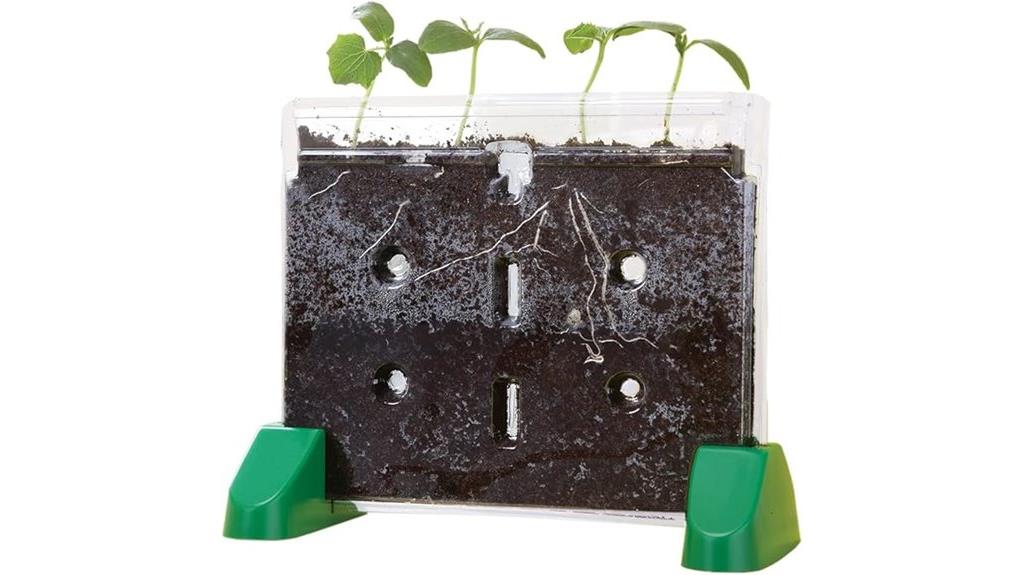
If you want a hands-on gardening experience that sparks curiosity and teaches fundamental science concepts, the Educational Insights Sprout & Grow Window is an excellent choice for children ages 5 and up. This transparent, self-standing kit lets kids watch seeds grow into sprouts, revealing roots underground and leaves above soil. It includes bean and pea seeds, WonderSoil, and detailed instructions with activities, making learning fun and interactive. The large plastic window provides clear visibility of plant development, encouraging observation and inquiry. Its compact design fits easily on windowsills or tabletops, making it perfect for small spaces and classroom projects. It’s a simple, engaging way to introduce children to plant biology.
Best For: children ages 5 and up interested in hands-on science, gardening, and natural learning experiences.
Pros:
- Encourages active observation and scientific inquiry in young learners
- Compact, easy to use, and suitable for small spaces or classroom settings
- Reusable with proper care, offering ongoing educational value
Cons:
- Plastic window can be fragile and prone to breakage if handled roughly
- Some users experience leakage or difficulty removing plants for transplanting
- Limited soil quantity may require additional planting sessions or seed experimentation
Root Viewer Kit for Kids
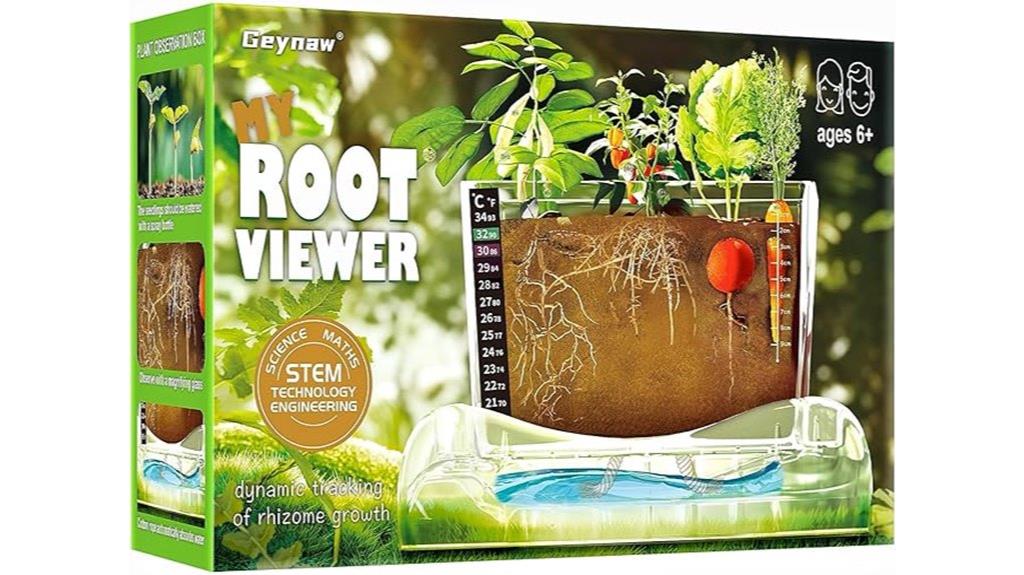
The Root Viewer Kit for Kids stands out as an ideal choice for children aged 6 to 10 who are enthusiastic to explore plant science firsthand. I love how this kit features a large transparent window that reveals underground root systems, making it easy for kids to observe plant growth directly. It includes essential gardening tools, a water tank, stickers, and an easy guidebook, all made from safe, durable materials. This hands-on experience fosters curiosity, patience, and responsibility while teaching kids about root development and plant biology. It’s perfect for home, classroom, or outdoor learning, offering endless fun and educational value.
Best For: children aged 6-10 who are curious about plant science, gardening, and hands-on learning experiences.
Pros:
- Engages kids with a clear see-through window to observe underground root growth firsthand.
- Includes durable, non-toxic materials and all necessary tools for safe, repeated use.
- Promotes educational growth, patience, and responsibility through interactive gardening activities.
Cons:
- May require supervision for younger children during planting and watering tasks.
- Limited to certain seed types, which might need to be supplemented for variety.
- Suitable primarily for indoor use; outdoor conditions could affect visibility or durability.
Subtoy Kids Plant Growing Kit with Greenhouse and Solar Lights

Parents looking for an engaging, educational, and therapeutic activity will find the Subtoy Kids Plant Growing Kit with Greenhouse and Solar Lights to be an excellent choice. This kit includes a greenhouse, indoor gardening set, solar-powered LED grow lights, a science irrigation system, and a flower grow room, making it all-encompassing and easy to use. Its self-watering design ensures plants stay hydrated for weeks, while the solar lights support healthy growth day and night. Perfect for children ages 6-12, it teaches biology, patience, and responsibility. Plus, gardening’s calming effects help reduce anxiety and boost mood, making it a meaningful and enjoyable learning experience.
Best For: parents and educators seeking an engaging, educational, and therapeutic gardening activity for children aged 6-12 that promotes learning, emotional regulation, and responsibility.
Pros:
- Combines educational, emotional, and recreational benefits in one comprehensive kit.
- Supports emotional regulation and reduces anxiety through tactile gardening activities.
- Easy-to-follow instructions and self-watering system make it suitable for beginners.
Cons:
- Requires some adult supervision and assistance for younger children.
- Limited to indoor use, which may not suit those with limited space.
- The initial setup might be time-consuming for younger children to complete independently.
Terrarium Kit for Kids, Plant Growing & STEM Toy Set for Ages 4-8

Designed specifically for children aged 4 to 8, the Terrarium Kit for Kids combines fun with education by featuring a solar-powered, transparent planter that makes plant growing accessible and engaging. It includes built-in LED lights for nighttime viewing, ensuring plants get light day and night. This CPSC-certified kit is safe and reliable, perfect for young learners. Gardening with this kit helps reduce stress, improve focus, and boost confidence. Kids can plant, care for, and observe their mini ecosystem, fostering social interaction and a sense of accomplishment. It’s an ideal gift that encourages curiosity, responsibility, and a love for nature in young children.
Best For: children aged 4-8 who are interested in gardening, STEM activities, and hands-on learning experiences.
Pros:
- Encourages educational development in science, responsibility, and creativity.
- Features solar-powered lighting and built-in LEDs for engaging nighttime viewing.
- Promotes social interaction and boosts confidence through planting and caring for plants.
Cons:
- May require adult supervision for younger children to ensure proper use.
- Limited plant options suitable for the small terrarium environment.
- The kit’s durability might vary with frequent handling by energetic children.
Creativity for Kids Grow N Glow Terrarium Kit

Kids aged 6 to 8 who love science, art, and hands-on projects will find the Creativity for Kids Grow N’ Glow Terrarium Kit especially engaging. This all-in-one kit lets children create their own mini ecosystem inside a mason-style jar, combining planting, decorating, and learning about nature. It includes seeds, soil, decorative stickers, glowing sand, and glow-in-the-dark figurines, making the experience both educational and magical. Kids can watch their plants grow, decorate the terrarium, and enjoy the glow at night. Designed for two planting cycles, it encourages responsibility, patience, and creativity while providing a fun, screen-free activity that fosters curiosity about ecosystems.
Best For: children aged 6-8 who enjoy hands-on science, arts & crafts, and nature exploration, seeking a fun, educational, and screen-free activity.
Pros:
- Encourages creativity, responsibility, and patience through planting and decorating.
- Includes all materials needed for two planting cycles, supporting repeated play and learning.
- Glow-in-the-dark features add a magical, engaging nighttime visual experience.
Cons:
- Attaching decorative elements like stickers may be challenging for some children.
- Some seeds may produce more plants than needed, though the kit remains easy to use.
- Limited to children within the specified age range, making it less suitable for older kids or teens.
Root Viewer Science Kit for Kids
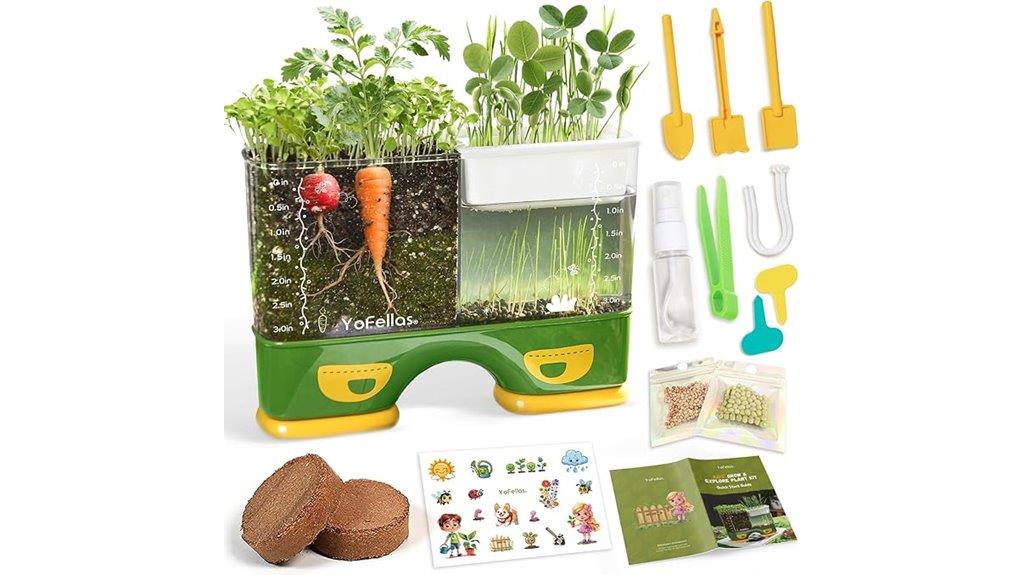
Ever wondered how roots grow beneath the surface? The Root Viewer Science Kit for Kids makes it possible to see that firsthand. Designed for children ages 6-12, it features a transparent root viewer that reveals real-time root, stem, and leaf development. The kit offers a unique 2-in-1 system, allowing kids to experiment with soil and hydroponic planting. It also includes an interactive journal and stickers to track progress and stay engaged. Perfect for sparking curiosity and teaching biology, this kit combines hands-on gardening with science, making learning fun and accessible. It’s an ideal gift for young aspiring botanists enthusiastic to explore nature’s unseen world.
Best For: children aged 6-12 who are curious about plants, science, and ecology, and enjoy hands-on learning experiences.
Pros:
- Transparent root viewer allows real-time observation of plant growth.
- 2-in-1 system offers both soil and hydroponic planting experiments.
- Includes an interactive journal and stickers to encourage engagement and creativity.
Cons:
- May require adult supervision for younger children during planting.
- Limited to basic plant types; not suitable for advanced botanical study.
- Some components might need replacement or additional tools for extended use.
National Geographic Crystal Growing Kit for Kids
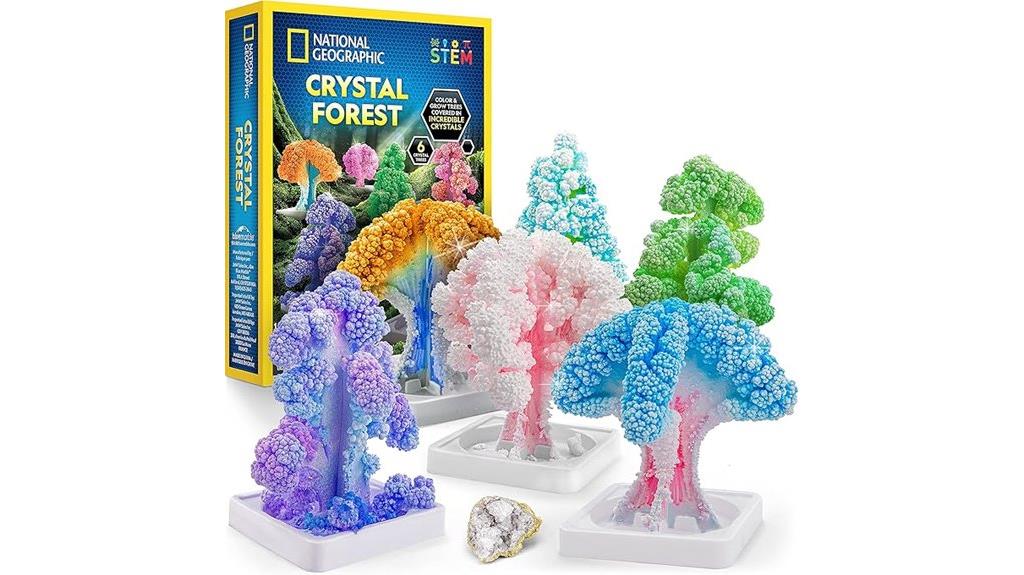
The National Geographic Crystal Growing Kit for Kids stands out as an excellent choice for young science enthusiasts enthusiastic to explore geology and crystallography firsthand. I love how it lets kids grow six different crystal trees—evergreen, cherry, bonsai, and dragon blood—in just six hours. The kit combines science and art, allowing children to color their trees and examine real geodes, making learning both fun and interactive. With a clear, educational guide and safe materials, it promotes curiosity about crystals, geology, and STEM concepts. Despite some crystals being fragile, kids get an engaging, hands-on experience that sparks creativity and scientific interest in a short, rewarding activity.
Best For: young science enthusiasts and families seeking an engaging, educational, and creative STEM activity in a fun, hands-on crystal growing kit.
Pros:
- Combines science and art with quick-growing, colorful crystals and real geodes for a tactile learning experience.
- Includes a comprehensive, easy-to-follow educational guide that promotes curiosity about geology and crystals.
- High-quality, safe materials suitable for kids, making it an ideal bonding activity for families or classroom use.
Cons:
- Crystals are fragile and may crumble or fall off if jostled, requiring careful handling.
- Crystals are temporary; they do not last long and may need to be displayed promptly.
- The activity can be messy, with potential spills from applying crystal solutions and handling wet or delicate crystals.
WKLOUYHE Root Viewer Kit for Kids
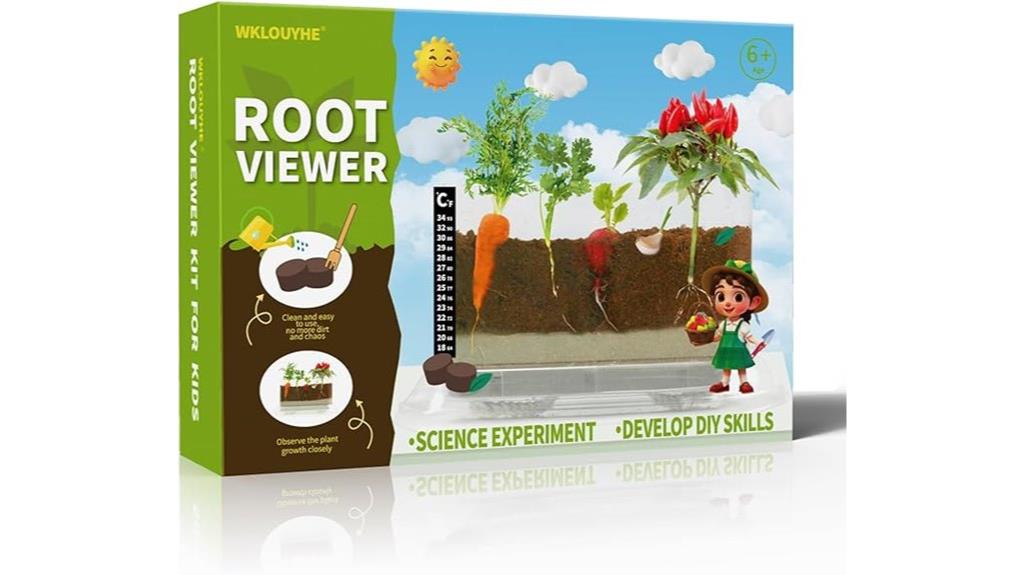
The WKLOUYHE Root Viewer Kit for Kids is an excellent choice for young children aged 6 to 10 who are enthusiastic to explore plant growth firsthand. Its transparent observation window allows kids to see underground roots and watch their plants develop in real time. The all-in-one kit includes seeds, self-expanding soil, tools, and a guidebook with easy-to-follow instructions. Kids can personalize their experience with stickers and a journal to track progress. This hands-on kit combines fun with learning, helping children understand plant biology, responsibility, and patience. It’s perfect for homeschooling, science projects, or as a thoughtful gift that sparks curiosity about nature.
Best For: young children aged 6 to 10 who are curious about plant growth, science projects, or homeschooling activities.
Pros:
- Engages kids with a transparent window to observe underground roots, enhancing curiosity and learning.
- Includes all necessary tools, seeds, and educational materials for a comprehensive gardening experience.
- Promotes hands-on learning, responsibility, and understanding of plant biology through interactive activities.
Cons:
- Some users report missing seeds or insufficient soil in the packaging.
- Parts may feel flimsy or less durable, affecting long-term use.
- Instructions could be clearer to ensure smooth assembly and use for first-time users.
4M Green Science Grow A Maze Kit
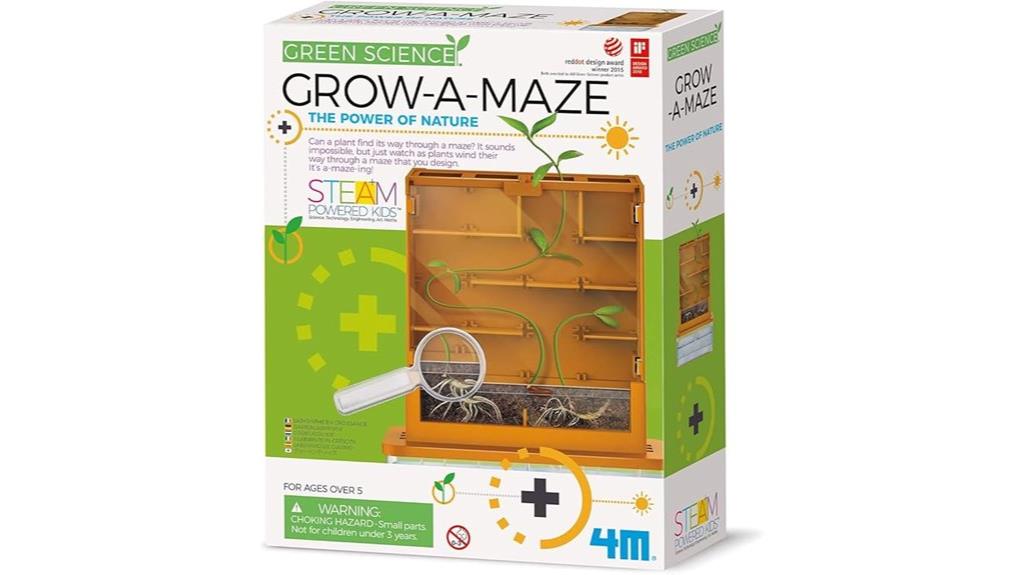
If you’re looking for a hands-on science kit that combines plant growth with interactive learning, the M Green Science Grow A Maze Kit is an excellent choice for young children and educators. It lets kids plant a bean and watch it sprout, winding through an adjustable maze inside a transparent container. The kit includes a mini-magnifying glass, a water pot, and a reusable maze, making observation fun. While assembly can be tricky due to flimsy parts, it promotes understanding of plant biology, sustainability, and upcycling. Keep in mind, seeds and soil aren’t included, so you’ll need to gather those separately. Overall, it’s an engaging, eco-friendly educational tool.
Best For: young children, educators, and parents seeking an engaging and educational science activity focused on plant growth and environmental concepts.
Pros:
- Encourages hands-on learning about plant biology and sustainable practices.
- Includes observation tools like a mini-magnifying glass for detailed viewing.
- Promotes fine motor skills and problem-solving through assembly and planting activities.
Cons:
- Assembly can be challenging due to flimsy or poorly fitting parts.
- Seeds and soil are not included, requiring additional purchase.
- The size and design may be smaller or less sturdy than expected, leading to potential stability issues.
Kids Plant Growing Kit with Drip Irrigation and Grow Light
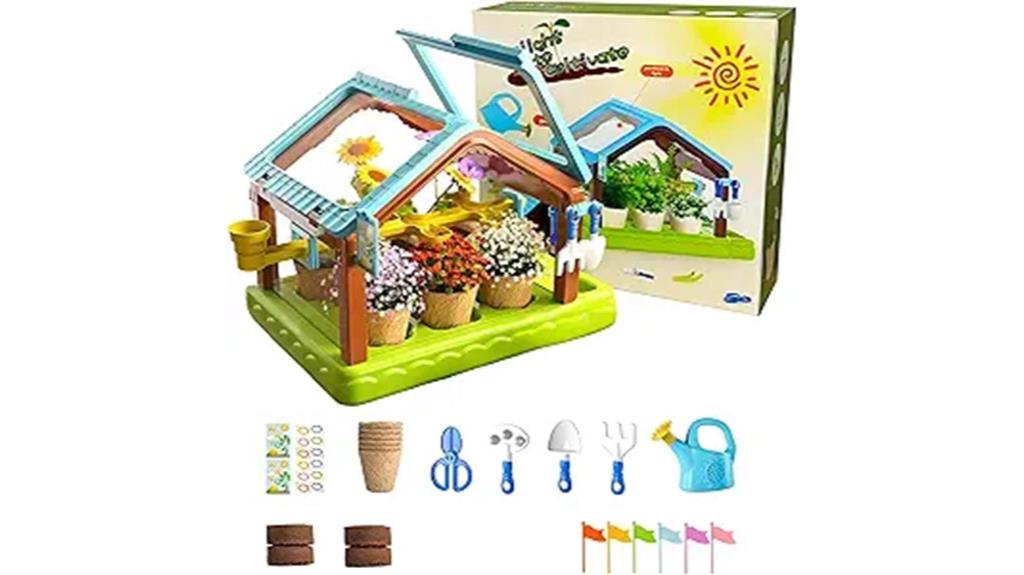
Designed specifically for young beginners, the Kids Plant Growing Kit with Drip Irrigation and Grow Light offers a user-friendly setup that makes indoor gardening accessible and fun. Its greenhouse features a 360-degree panoramic transparent roof, making it easy for kids to observe plant growth. The kit includes a water tank drip irrigation system and an exterior light strip that supports all-season growth. Adjustable vents help control the environment, ensuring healthy plants year-round. Made from safe, burr-free ABS material, it’s perfect for children to assemble with illustrated instructions. This all-encompassing kit encourages hands-on learning about plant life cycles, photosynthesis, and responsible gardening skills.
Best For: parents and educators seeking an engaging, safe, and educational indoor gardening kit for young children to explore plant growth and biology.
Pros:
- Supports all-season gardening with adjustable vents and grow lights for optimal plant care.
- Made from safe, burr-free ABS material ensuring durability and child safety during assembly and use.
- Enhances learning through hands-on activities that teach plant life cycles, photosynthesis, and responsibility.
Cons:
- Requires supervision for proper setup and ongoing care, which may be challenging for very young children.
- Limited to indoor environments; outdoor gardening is not supported.
- Assembly instructions, while illustrated, may still pose difficulty for very young or inexperienced children without adult assistance.
STEM Craft Kit for Kids Ages 6-12
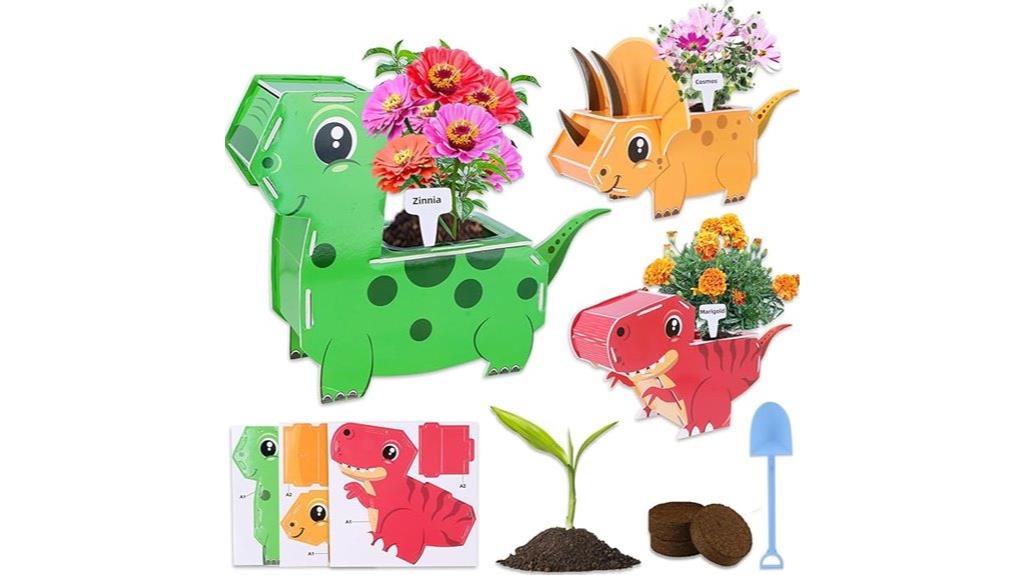
Kids aged 6 to 12 who love hands-on activities will find the STEM Craft Kit for them, because it combines puzzles, planting, and science into an engaging, screen-free experience. This all-in-one kit includes a 3D dinosaur puzzle, seeds, soil, markers, a shovel, and plant boxes, offering a complete gardening adventure. Kids can build, plant, and watch their flowers grow while learning about plant life cycles, patience, and responsibility. Designed for educational fun, it encourages creativity and curiosity without screens. Perfect as a birthday gift or a classroom activity, this kit makes STEM learning accessible and exciting for young learners.
Best For: children aged 6 to 12 who enjoy hands-on, educational STEM activities that combine creativity, science, and nature without the need for screens.
Pros:
- Encourages hands-on learning through puzzles, planting, and science experiments.
- Includes all necessary tools and materials, making it convenient and comprehensive.
- Promotes patience, responsibility, and understanding of plant life cycles in a fun way.
Cons:
- May require adult supervision for younger children during planting and assembly.
- Limited to the activities included; may not sustain interest for extended periods.
- Suitable mainly for children interested in gardening, science, or puzzles, which could limit appeal for some kids.
Factors to Consider When Choosing Plant-Growing Science Kits
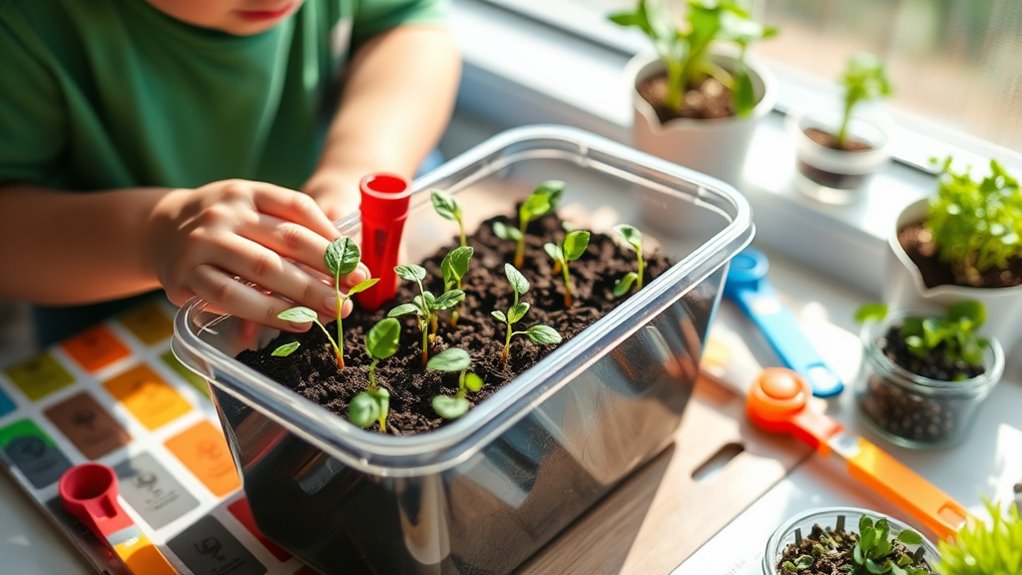
When choosing a plant-growing science kit, I think about factors like age appropriateness and the educational focus to make certain it’s suitable and engaging. I also consider the growing method and included materials because they affect how easy and fun the experience will be. Finally, I look at how simple the kit is to use to make sure it’s accessible for the intended age group.
Age Appropriateness
Choosing the right plant-growing science kit depends heavily on the child’s age and developmental stage. It’s important to select a kit with a recommended age range that matches your child’s abilities to guarantee safety and appropriate challenge. For younger kids (ages 3-6), look for kits with simple instructions, larger parts, and minimal assembly to prevent frustration or choking hazards. Kids aged 8-12 benefit from more advanced kits that include scientific experiments and educational activities to deepen their understanding. Also, consider whether the kit’s content aligns with your child’s interests in plants, gardening, or science—this helps keep them engaged. Make sure the reading level of the materials matches their skills, so they can explore and learn independently without feeling overwhelmed.
Educational Focus
The educational focus of a plant-growing science kit shapes what children will learn and how they develop their scientific skills. I look for kits that emphasize core concepts like photosynthesis, plant biology, or ecological responsibility, as these foster curiosity and understanding. Kits that incorporate STEM activities—such as root observation, hydroponics, or crystal growth—encourage inquiry and critical thinking. Instructional materials like manuals or activity guides are essential, as they provide explanations, facts, and challenges aligned with learning goals. It’s also important that the complexity matches the child’s age and developmental level, ensuring engagement without frustration. A well-designed kit with a clear educational focus can inspire a long-term interest in science and environmental awareness through hands-on, experiential learning.
Growing Method
Selecting the right growing method for a plant-science kit depends on the learning goals and the child’s age. Different methods—soil planting, hydroponics, or aeroponics—offer unique experiences. Soil-based kits include soil and seeds, providing a traditional gardening feel that emphasizes nutrient management and root development. Hydroponic kits grow plants in nutrient-rich water, often resulting in faster growth and easier observation of water transport and roots. Some kits combine soil and hydroponic systems, enabling kids to compare methods and deepen their understanding of plant biology. The growing method also impacts the kit’s complexity, setup time, and educational focus. Choosing the appropriate method guarantees the experience aligns with the child’s developmental stage and curiosity, making plant science both fun and instructive.
Included Materials
When picking a plant-growing science kit, it’s important to pay attention to the included materials, as they directly influence the variety of plants you can grow and how successful the germination process will be. The number and types of seeds determine the species and growth duration, so more options mean a richer experience. Essential components like soil, growing mediums, and water systems are crucial for healthy plants and successful germination. Additional tools such as planting markers, watering devices, and labels help kids stay organized and track their progress effectively. Some kits also include educational booklets, stickers, or decorative elements, which boost engagement and learning. Lastly, eco-friendly or sustainable materials promote environmental awareness and ensure safe handling for young gardeners.
Ease of Use
Choosing an easy-to-use plant-growing science kit means looking for features that simplify the planting process and minimize frustration. Look for kits with clear instructions and minimal assembly steps so kids can start planting quickly. Pre-measured or self-expanding soil reduces the need for extra tools, making the setup straightforward. Kits with automatic watering systems or drip irrigation help children maintain proper moisture levels without constant attention. User-friendly design elements, like large, colorful labels and simple component arrangements, make the experience accessible for younger kids. Visual guides or step-by-step instructions also boost independence and confidence. Prioritizing these features guarantees the planting process is enjoyable, educational, and achievable, encouraging kids to become enthusiastic young botanists without feeling overwhelmed.
Durability and Quality
Durability and quality are essential factors to consider when picking a plant-growing science kit, as they determine how well the kit holds up over time and during various uses. High-quality kits feature non-toxic, resilient materials like sturdy plastic containers and reinforced observation windows that withstand frequent handling. The longevity of these components ensures the kit can be used repeatedly, providing lasting educational value. Well-made kits also include secure, properly fitted pieces and weather-resistant elements, protecting them during indoor or outdoor activities. Additionally, reputable kits often meet strict manufacturing standards and safety certifications, reflecting their focus on durable and reliable construction. Choosing a kit built with quality materials guarantees it remains functional and safe, offering a satisfying experience for both kids and parents.
Space Requirements
Considering the space you have available is essential when selecting a plant-growing science kit, as it guarantees the setup fits comfortably without cluttering your home or classroom. First, assess the dimensions of the kit and decide if it needs a flat surface like a table, windowsill, or shelf for proper placement. Think about whether the kit’s size allows enough light exposure and ventilation for healthy plant growth. Some kits feature compact or multi-tiered designs, which help maximize limited space and accommodate multiple plants or experiments. Also, ensure there’s enough clearance around the kit for watering, maintenance, and observation without obstruction. Proper space planning guarantees the kit functions well and stays organized, making the planting experience enjoyable and manageable.
Price and Value
When evaluating the price and value of a plant-growing science kit, I focus on how the cost relates to the quality and quantity of the materials included. I compare the number of seeds, tools, and educational components to see if they justify the price. Kits with reusable features or extra activities tend to offer better long-term value, keeping kids engaged longer. I also check if instructions and educational content are extensive, which can justify a higher price by promoting deeper learning. It’s important to ensure the price aligns with similar kits on the market, so you get a good deal for what’s included. Be cautious of cheaper kits that may lack essential parts or durability, as they could lead to higher costs later on.
Frequently Asked Questions
How Do Plant-Growing Kits Promote Environmental Awareness in Children?
Plant-growing kits promote environmental awareness in children by engaging them directly with nature, teaching responsibility, and showing how plants grow. I’ve seen how kids become curious about ecosystems and sustainability through hands-on experience. When they nurture plants, they understand the importance of caring for the environment. These kits make learning fun and meaningful, inspiring young minds to appreciate and protect our planet for the future.
Can These Kits Be Used for Educational Purposes Beyond Home Use?
Absolutely, these kits are perfect for educational purposes beyond home. I see them as tiny seeds of curiosity that can grow in classrooms, community centers, or summer camps. They symbolize hope and renewal, inspiring children to nurture not just plants but also their understanding of ecology and sustainability. Using them in diverse settings helps cultivate future environmental stewards, making learning about nature both meaningful and memorable.
What Safety Features Are Included in Kids’ Plant-Growing Science Kits?
Kids’ plant-growing science kits typically include safety features like non-toxic, child-safe materials and clear instructions to prevent mishaps. I always look for kits with easy-to-understand labels and protective gloves or tools to guarantee safety during hands-on activities. These features help children learn about plants confidently while minimizing risks. Always supervise young gardeners and follow the provided guidelines for a safe, fun, and educational experience.
Are There Kits Suitable for Children With Allergies or Sensitivities?
Think of these kits as gentle rain nurturing delicate plants—many are designed for children with allergies or sensitivities. I always look for options labeled hypoallergenic or made with natural, non-toxic materials. Some kits avoid common allergens like latex or certain pesticides. By choosing thoughtfully, you can help your child explore nature safely, turning curiosity into a blossoming passion without worries about sensitivities.
How Do Plant Kits Support Learning About Sustainability and Conservation?
Plant kits support learning about sustainability and conservation by teaching kids how plants grow, their role in ecosystems, and the importance of caring for our environment. I love that they encourage responsible gardening, composting, and understanding resource use. These hands-on experiences inspire young botanists to appreciate nature’s delicate balance, fostering a sense of stewardship and motivating them to protect our planet for future generations.
Conclusion
If you’re looking to spark your child’s love for botany, these kits are a fantastic start. I saw a friend’s 10-year-old transform their kitchen window into a mini garden, thanks to a simple sprout kit. Imagine the pride they’ll feel watching their own plants grow! Whether they prefer hydroponics or traditional planting, these kits make learning fun and hands-on. Give your young scientist the tools to explore and watch their curiosity blossom!





